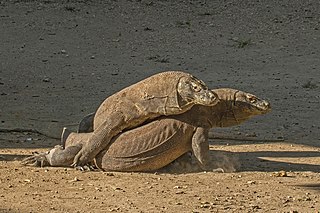
The Varanidae are a family of lizards in the superfamily Varanoidea within the Anguimorpha group. The family, a group of carnivorous and frugivorous lizards, includes the living genus Varanus and a number of extinct genera. Varanus includes the Komodo dragon, crocodile monitor, savannah monitor, the goannas of Australia and Southeast Asia, and various other species with a similarly distinctive appearance. Their closest living relatives are the anguid and helodermatid lizards.

Monitor lizards are lizards in the genus Varanus. They are native to Africa, Asia, and Oceania, and one species is also found in the Americas as an invasive species. About 80 species are recognized.

The Nile monitor is a large member of the monitor family (Varanidae) found throughout most of Sub-Saharan Africa and along the Nile. The population in West African forests and savannahs is sometimes recognized as a separate species, the West African Nile monitor. It is one of the largest lizards in the world reaching and even surpassing the perentie by size. Other common names include the African small-grain lizard, as well as iguana and various forms derived from it, such as guana, water leguaan or river leguaan,
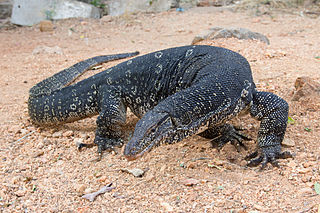
The Asian water monitor is a large varanid lizard native to South and Southeast Asia. It is one of the most common monitor lizards in Asia, ranging from coastal northeast India, Bangladesh, Sri Lanka, mainland Southeast Asia, and southern China to Indonesian islands where it lives close to water. It is listed as Least Concern on the IUCN Red List. It was described by Laurenti in 1768 and is among the largest squamates in the world.
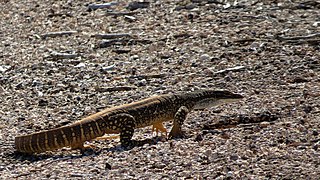
The sand goanna is a species of large Australian monitor lizard, also known as Gould's monitor, sand monitor, or racehorse goanna.

The savannah monitor is a medium-sized species of monitor lizard native to Africa. The species is known as Bosc's monitor in Europe, since French scientist Louis Bosc first described the species. It belongs to the subgenus Polydaedalus.

The mangrove monitor, mangrove goanna, or Western Pacific monitor lizard is a member of the monitor lizard family with a large distribution from northern Australia and New Guinea to the Moluccas and Solomon Islands. It grows to lengths of 3.5 to 4 ft.

The yellow-spotted monitor, also known as the Argus monitor, is a monitor lizard found in northern and western regions of Australia and southern New Guinea.

The spiny-tailed monitor, also known as the Australian spiny-tailed monitor, the ridge-tailed monitor or Ackie's dwarf monitor, is an Australian species of lizard belonging to the genus of monitor lizards (Varanus).

The rock monitor is a species of monitor lizard in the family Varanidae. The species is endemic to Central, East, and southern Africa. It is the second-longest lizard found on the continent, and the heaviest-bodied; locally, it is called leguaan or likkewaan.

Mertens' water monitor, also called commonly Mertens's water monitor, and often misspelled Mertin's water monitor, is a species of lizard in the family Varanidae. The species is endemic to northern Australia, and is a wide-ranging, actively foraging, opportunistic predator of aquatic and riparian habitats. It is named after German herpetologist Robert Mertens.
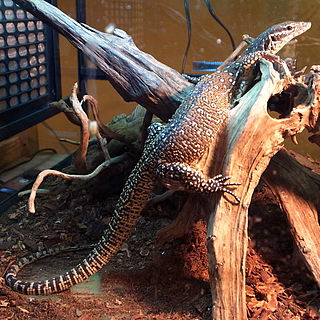
The peacock monitor, also known commonly as Auffenberg's monitor, is a species of small monitor lizard in the family Varanidae. The species, which belongs to the subgenus Odatria, is endemic to Rote Island, Indonesia.
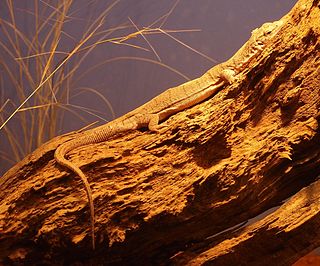
The pygmy mulga monitor, also known as Gillen's monitor or just mulga monitor is a species of lizard in the family Varanidae.

The Kimberley rock monitor is a medium-sized species of monitor lizard in the family Varanidae. The species is native to Northern Australia. Also known as Glauert's monitor or the Kakadu sand goanna, it belongs to the subgenus Odatria.

The peach-throated monitor, also known commonly as the Sepik monitor, is a species of monitor lizard in the family Varanidae. The species is native to New Guinea.
The Pilbara monitor, also known commonly as Bush's monitor, Bush's pygmy monitor, and the Pilbara mulga goanna, is a species of monitor lizard in the family Varanidae. The species is endemic to Australia.
The black-spotted ridge-tailed monitor, also called commonly the black-spotted spiny-tailed monitor, the lemon-throated monitor, the northern ridge-tailed monitor, Whites monitor, and the yellow-throated monitor, is a species of lizard in the family Varanidae. The species is native to Australia's tropical Northern Territory. It is listed as Least Concern on the IUCN Red List as it is considered common and not threatened. It was first described in 1987. It is also known as White's dwarf goanna.

The turquoise monitor is a species of monitor lizards found in Indonesia. Specifically, it is found on Halmahera Island and in the Maluku Islands.

Dumeril's monitor is a species of lizard, endemic to Southeast Asia. It is a member of the family Varanidae.
The Rennell Island monitor is a species of monitor lizards found in the Solomon Islands archipelago. It is also known as the Hakoi Monitor. It belongs to the subgenus Euprepiosaurus along with the canopy goanna, the peach-throated monitor, Kalabeck's monitor, and others.
















